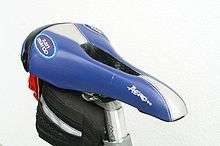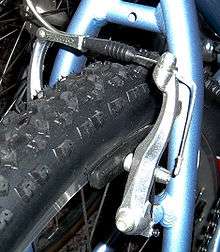Outline of bicycles
The following outline is provided as an overview of and topical guide to bicycles:
Bicycle – pedal-driven, human-powered, single-track vehicle, having two wheels attached to a frame, one behind the other. A person who rides a bicycle is called a cyclist or a bicyclist, and the activity is called cycling. Also known as a bike, push bike or cycle.
What type of thing is a bicycle?
Bicycles can be described as all of the following:
- a component of transport
- a component of a mode of transport
- a component of road transport
- a type of vehicle
- Human-powered transport
- a component of road transport
- a component of a mode of transport
Types of bicycles
- 27.5 mountain bike
- 29er
- Art bike
- Autobike
- Balance bicycle
- Bamboo bicycle
- Beach cruiser
- Belt-driven bicycle
- Bicycle trailer
- Big Wheel (tricycle)
- Billboard bicycle
- Bixi
- BMX bike
- Boda-boda
- Cardboard bicycle
- Chainless bicycle
- Chopper bicycle
- Chukudu
- City bike
- Clown bicycle
- Conference Bike
- Cruiser bicycle
- Cycle rickshaw
- Cyclo-cross bicycle
- Dekochari
- Dicycle
- Downhill bike
- Electric bicycle
- European city bike
- Faired bicycle
- Fatbike
- Flat bar road bike
- Folding bicycle
- Freight bicycle
- Gearbox bicycle
- Handcycle
- Hybrid bicycle
- Hydrogen bicycle
- Ice cycle
- Infantry bicycle
- Islamic bicycle
- Longtail bicycle
- Lowrider bicycle
- Military bicycle
- Monowheel
- Motorized bicycle
- Mountain bike
- Party Bike
- Path Racer
- Penny-farthing
- Police bicycle
- Portable bicycle
- Porteur bicycle
- Prone bicycle
- Racing bicycle
- Railbike
- Randonneur
- Recumbent bicycle
- Road bicycle
- Roadster bicycle
- Rowing cycle
- Scraper bike
- Shaft-driven bicycle
- Sideways bike
- Single-speed bicycle
- Small wheel bicycle
- Stationary bicycle
- Swing Bike
- Tall bike
- Tandem bicycle
- Time trial bicycle
- Touring bicycle
- Track bicycle
- Trailer bike
- Treadle bicycle
- Triathlon bicycle
- Utility cycling
- Velocipede
- Velomobile
- Wheelie bike
- Wheelie bike
- Wooden bicycle
- Workbike
- Xtracycle
History of bicycles
Key developments
- draisine, dandy horse, or Laufmaschine
- boneshaker
- velocipede
- Penny-farthing, high wheel, high wheeler, or ordinary
- safety bicycle
People
Early developers
- Karl von Drais
- Thomas Humber
- Pierre Lallement
- Thomas McCall
- John McCammon
- Eugène Meyer
- Pierre Michaux
- Mikael Pedersen
- Albert Augustus Pope
- John Kemp Starley
Other developers
Mountain bike developers
Other notable cyclists
- Lenz, Frank
- Murphy, Charles Minthorn, also known as Mile-a-Minute Murphy
- Taylor, Marshall Walter, also known as Major Taylor
Racing authors
Other authors
- Brown, Sheldon (bicycle mechanic)
- Forester, John ("the father of Vehicular Cycling")
- Byrne, David (musician and artist)
- Herlihy, David V. (historian)
Organizations
- cycling club
- International Cycling History Conference
- League of American Bicyclists
- Mountain Bike Hall of Fame
- National Off-Road Bicycle Association
- Union Cycliste Internationale
- USA Cycling
- World Human Powered Vehicle Association
Technical aspects
The bicycle has undergone continual adaptation and improvement since its inception. These innovations have continued with the advent of modern materials and computer-aided design, allowing for a proliferation of specialized bicycle types.
Uses
Bicycles have been and are employed for many uses:
- Cycling – use of bicycles for transport, recreation, or for sport.[1]
- Utility: bicycle commuting and utility cycling
- Work: mail delivery, paramedics, police, couriering, and general delivery.
- Recreation: bicycle touring, mountain biking, BMX and physical fitness.
- Racing: track racing, criterium, roller racing and time trial to multi-stage events like the Tour of California, Giro d'Italia, the Tour de France, the Vuelta a España, the Volta a Portugal, among others.
- Military: scouting, troop movement, supply of provisions, and patrol. See bicycle infantry.
- Show: entertainment and performance, e.g. circus clowns. Used as instrument by Frank Zappa.
Types of bicycles
List of bicycle types Bicycles can be categorized in different ways: e.g. by function, by number of riders, by general construction, by gearing or by means of propulsion. The more common types include utility bicycles, mountain bicycles, racing bicycles, touring bicycles, hybrid bicycles, cruiser bicycles, and BMX Bikes. Less common are tandems, lowriders, tall bikes, fixed gear, folding models and recumbents (one of which was used to set the IHPVA Hour record).
Unicycles, tricycles and quadracycles are not strictly bicycles, as they have respectively one, three and four wheels, but are often referred to informally as "bikes".
Dynamics
Bicycle and motorcycle dynamics
Performance
Geometry
Bicycle and motorcycle geometry
Construction and parts
In its early years, bicycle construction drew on pre-existing technologies. More recently, bicycle technology has in turn contributed ideas in both old and new areas.
For details on specific bicycle parts, see list of bicycle parts and category:bicycle parts.
Frame
Bicycle frame The great majority of today's bicycles have a frame with upright seating which looks much like the first chain-driven bike.
By design:
By frame material:
Brands and makers of unusual frames:
Drivetrain and gearing
Power collection
Power transmission
Power modification
- bicycle gearing
- derailleur gears
- electronic gear-shifting system
- gearbox bicycle
- hub gear
- shifter
- single-speed bicycle
Power application
Steering and seating
Brakes
Suspension
Wheels and tires
Tracks
Some bicycles are built for specific tracks:
Or special tracks are built specifically for bicycles:
Bicycle accessories
- Bicycle basket
- Bicycle bell
- Bicycle helmet
- Bicycle lighting and bicycle reflector
- Bicycle pump and CO2 inflator
- Bicycle rollers
- Bicycle tools
- Bicycle trailer
- Bicycle trainer
- Bike lock
- Bottle cages and water bottles
- Chainguard
- Child seats
- Clipless pedals
- Cycling power meter
- Cyclocomputer and cycling power meter
- Kick stand
- Luggage carrier
- Mudguard or fender
- Panniers
- Saddlebag
- Sidecar
- Tire lever
- Toe-clips and toestraps
- Training wheels
Bicycle tools
Standards
A number of formal and industry standards exist for bicycle components to help make spare parts exchangeable and to maintain a minimum product safety.
The International Organization for Standardization, ISO, has a special technical committee for cycles, TC149, that has the following scope: "Standardization in the field of cycles, their components and accessories with particular reference to terminology, testing methods and requirements for performance and safety, and interchangeability."
CEN, European Committee for Standardisation, also has a specific Technical Committee, TC333, that defines European standards for cycles. Their mandate states that EN cycle standards shall harmonize with ISO standards. Some CEN cycle standards were developed before ISO published their standards, leading to strong European influences in this area. European cycle standards tend to describe minimum safety requirements, while ISO standards have historically harmonized parts geometry. The TC149 ISO bicycle committee, including the TC149/SC1 ("Cycles and major sub-assemblies") subcommittee, has published the following standards:
- ISO 4210 Cycles—Safety requirements for bicycles
- ISO 6692 Cycles—Marking of cycle components
- ISO 6695 Cycles—Pedal axle and crank assembly with square end fitting—Assembly dimensions
- ISO 6696 Cycles—Screw threads used in bottom bracket assemblies
- ISO 6697 Cycles—Hubs and freewheels—Assembly dimensions
- ISO 6698 Cycles—Screw threads used to assemble freewheels on bicycle hubs
- ISO 6699 Cycles—Stem and handlebar bend—Assembly dimensions
- ISO 6701 Cycles—External dimensions of spoke nipples
- ISO 6742 Cycles—Lighting and retro-reflective devices—Photometric and physical requirements
- ISO 8090 Cycles—Terminology (same as BS 6102-4)
- ISO 8098 Cycles—Safety requirements for bicycles for young children
- ISO 8488 Cycles—Screw threads used to assemble head fittings on bicycle forks
- ISO 8562 Cycles—Stem wedge angle
- ISO 10230 Cycles—Splined hub and sprocket—Mating dimensions
- ISO 11243 Cycles—Luggage carriers for bicycles—Concepts, classification and testing
Other ISO Technical Committees have published various cycle relevant standards, for example:
- ISO 5775 Bicycle tire and rim designations
- ISO 9633 Cycle chains—Characteristics and test methods
Published cycle standards from CEN TC333 include:
- EN 14764 City and trekking bicycles – Safety requirements and test methods
- EN 14765 Bicycles for young children – Safety requirements and test methods
- EN 14766 Mountain-bicycles – Safety requirements and test methods
- EN 14781 Racing bicycles – Safety requirements and test methods
- EN 14872 Bicycles – Accessories for bicycles – Luggage carriers
- EN 15496 Cycles – Requirements and test methods for cycle locks
Yet to be approved cycle standards from CEN TC333:
- EN 15194 Cycles—Electrically power assisted cycles (EPAC bicycle)
- EN 15532 Cycles—Terminology
- 00333011 Cycles – Bicycles trailers – safety requirements and test methods
Social and historical aspects

The bicycle has had a considerable effect on human society, in both the cultural and industrial realms.
Economic implications
In daily life
In poverty reduction
Legal requirements
The Vienna Convention on Road Traffic of the United Nations considers a bicycle to be a vehicle, and a person controlling a bicycle (whether actually riding or not) is considered an operator.
See also
General
- Bicycle locker
- List of bicycle and human powered vehicle museums
- List of bicycle brands and manufacturing companies
- Outline of cycling
Related vehicle types
Other
- Bicycle Shaped Object
- Safety standards
- Transportation technology, timeline of
References
- ↑ Oxford English Dictionary (Second ed.). Oxford University Press. 1989.
cycling: The action or activity of riding a bicycle etc.













